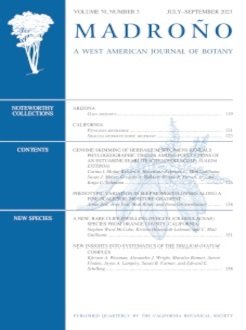Arizona
Gaga arizonica (Maxon) F.W.Li & Windham (PTERIDACEAE).—Pima County, Rincon Mountains, Upper Paige Creek, 0.7 km NE of Rincon Peak, Saguaro National Park, 32.122491, –110.515928 ± 20 m (WGS84), 2134 m (7000 ft), 8 Sep 2022, Beckman 302 with K. E. Lyons-Letts and M. N. Escobar (ARIZ), bedrock creek bank of open Pinus discolor D.K.Bailey & Hawksw. and Quercus chrysolepis Liebm. woodland, deeply shaded by towering granite outcrop to the southeast, with Salvia arizonica A.Gray, Rubus neomexicanus A.Gray, Ptelea trifoliata L., Holodiscus discolor (Pursh) Maxim., Selaginella underwoodii Hieron., Ageratina herbacea (A.Gray) R.M.King & H.Rob, Philadelphus microphyllus A.Gray, Brickellia parvula A.Gray, and Brickellia californica (Torr. & A.Gray) A.Gray; locally common along small creek and around base of outcrop (Fig. 1A, B, D). Also observed and photographed 21 Sep 2022 in the next small drainage to the west, 0.1 km SW of the collection locality at 2225 m (7300 ft) (Beckman 2022-09-21, SEINet Portal Network 2023) (Fig. 1C).
Fig. 1.
Gaga arizonica in the Rincon Mountains. A. Growth habit along rocky creek bank with Selaginella underwoodii (Photo: Daniel C. Beckman); B. Portrait of adaxial leaf surface (Photo: Keeley E. Lyons-Letts); C. Damp sheltered rocky ravine with Gaga arizonica visible in foreground among rocks in drainage bottom (Photo: Daniel C. Beckman); D. Abaxial leaf surface with marginal false indusia and sori underneath (Photo: Daniel C. Beckman).

Previous knowledge. Gaga arizonica was previously included in the large polyphyletic genus Cheilanthes Sw. Li, Pryer, and Windham (2012) segregated 17 species informally known as the “C. marginata group” into the new genus Gaga, along with two newly described species. Mexico is the center of diversity for Gaga, with species extending south to Bolivia and north to Arizona (G. arizonica) and Texas (G. kaulfussii (Kunze) F.W.Li & Windham). Grusz and Windham (2013) moved a larger group of primarily North and Central American Cheilanthes species into the resurrected genus Myriopteris Fée. Gaga arizonica ranges from southern Arizona through Mexico into Guatemala and Honduras. Previous U.S. records occurred in similar habitats: well-shaded, moist sites at high elevation, often associated with cliffs or steep canyon walls.
Significance. This is a northern range extension (ca. 40 km) for Gaga arizonica and the first report for Pima County and Saguaro National Park. Gaga arizonica is known in only three other U.S. mountain ranges (Huachuca, Mule, and Chiricahua) in ca. 7 localities, all significantly closer to the international border in Cochise County (Windham and Rabe 1993). NatureServe (2023) ranks this species as imperiled in Arizona (S2) and the United States (N2). The Rincon Mountains population is situated on the extremely steep east face of Rincon Peak, which hosts a fascinating plant community, little-described to this point due to rugged terrain and a lack of roads or trails. The dominant conifer along drainages and sheltered slopes is the climate relict Hesperocyparis arizonica (Greene) Bartel, a very rare forest type elsewhere in the Rincons. The area also hosts an additional cheilanthoid fern at its northern documented range limit, Myriopteris lendigera (Cav.) Fée, which occurs intermittently along drainages in sheltered rock crevices and north facing banks. Other noteworthy 2022 findings from the area included the Arizona endemic Erigeron pringlei A.Gray (Beckman 305, ARIZ), Woodsia plummerae Lemmon (Beckman 312, ARIZ), and Agave parryi Engelm. (Beckman & Gonzalez 313, ARIZ), all first records for the Rincon and Saguaro National Park floras.
Acknowledgments
I thank Western National Parks Association and Wild Tribute for funding our 2022 plant surveys, and Friends of Saguaro National Park for previous funding and continual project support. I am grateful to Saguaro National Park biologist Don Swann for supporting floristic and rare plant work in the park, as well as George Ferguson and the University of Arizona Herbarium for processing collections and assisting with research.





